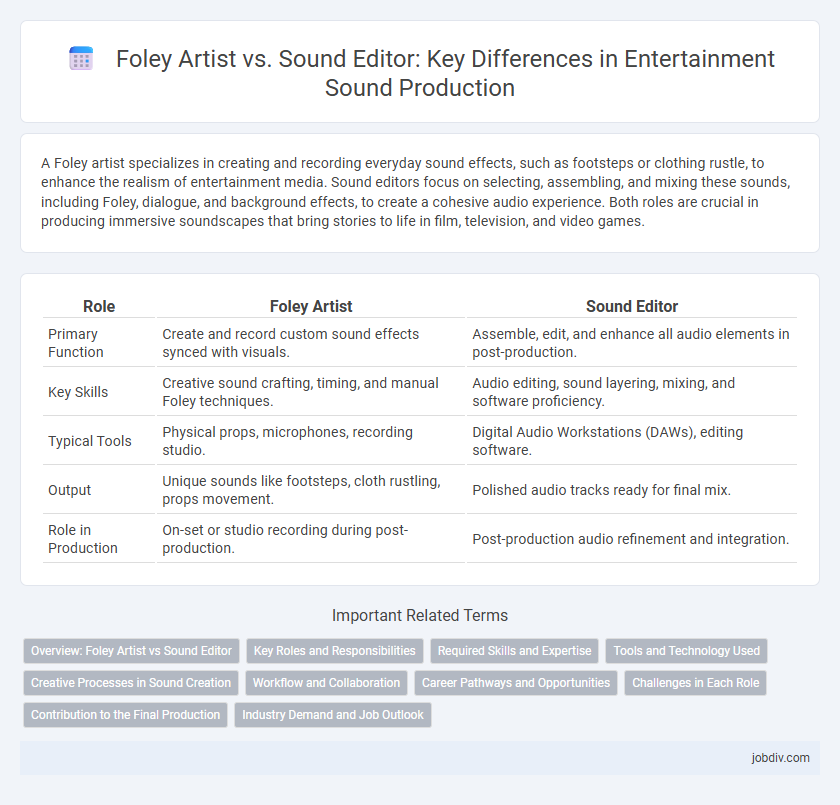A Foley artist specializes in creating and recording everyday sound effects, such as footsteps or clothing rustle, to enhance the realism of entertainment media. Sound editors focus on selecting, assembling, and mixing these sounds, including Foley, dialogue, and background effects, to create a cohesive audio experience. Both roles are crucial in producing immersive soundscapes that bring stories to life in film, television, and video games.
Table of Comparison
| Role | Foley Artist | Sound Editor |
|---|---|---|
| Primary Function | Create and record custom sound effects synced with visuals. | Assemble, edit, and enhance all audio elements in post-production. |
| Key Skills | Creative sound crafting, timing, and manual Foley techniques. | Audio editing, sound layering, mixing, and software proficiency. |
| Typical Tools | Physical props, microphones, recording studio. | Digital Audio Workstations (DAWs), editing software. |
| Output | Unique sounds like footsteps, cloth rustling, props movement. | Polished audio tracks ready for final mix. |
| Role in Production | On-set or studio recording during post-production. | Post-production audio refinement and integration. |
Overview: Foley Artist vs Sound Editor
A Foley artist creates and records custom sound effects that synchronize with on-screen actions, enhancing the realism and emotional impact of a film or television show. In contrast, a sound editor assembles, edits, and mixes various audio elements, including dialogue, background noises, and Foley sounds, to ensure clear and balanced soundtracks. Both roles are essential in post-production, with Foley artists specializing in live sound creation and sound editors focusing on audio integration and refinement.
Key Roles and Responsibilities
Foley artists create and record live sound effects that synchronize with on-screen actions to enhance realism and immersion, often using everyday objects to mimic footsteps, clothing rustles, and environmental sounds. Sound editors are responsible for selecting, assembling, and fine-tuning all audio elements, including dialogue, sound effects, and background scores, to ensure clarity, balance, and emotional impact within the final mix. Both roles collaborate closely to achieve a polished auditory experience that supports the storytelling in film, television, and other multimedia productions.
Required Skills and Expertise
Foley artists require a keen sense of creativity and acute auditory perception to replicate everyday sounds that enhance the realism of a film or television show. Sound editors must possess advanced technical skills in audio software, along with a deep understanding of sound layering, synchronization, and effects manipulation to create cohesive soundscapes. Both roles demand collaborative communication and time management abilities to meet production deadlines while maintaining high-quality auditory experiences.
Tools and Technology Used
Foley artists utilize physical props such as shoes, surfaces, and everyday objects combined with high-quality microphones and recording studios to create realistic sound effects that enhance visual storytelling. Sound editors rely on advanced software tools like Pro Tools, Adobe Audition, and digital audio workstations (DAWs) to manipulate, layer, and synchronize audio tracks with film or video content. Both professions leverage technology, but Foley artists focus on capturing organic sounds, while sound editors emphasize digital sound design and precision editing.
Creative Processes in Sound Creation
Foley artists use live recording techniques to recreate everyday sounds, emphasizing precise timing and physical interaction to match on-screen actions in film and television. Sound editors manipulate and layer audio elements digitally, enhancing or altering sounds to create immersive auditory experiences and maintain narrative coherence. Collaboration between Foley artists and sound editors ensures a seamless blend of authentic and enhanced sounds, crucial for the overall sound design in entertainment production.
Workflow and Collaboration
Foley artists create custom sound effects by performing everyday actions in a studio to enhance the realism of scenes, while sound editors meticulously assemble, edit, and mix these sounds to match the film's narrative flow. Their workflow involves constant collaboration through reviewing rough cuts and syncing audio elements with visual cues to ensure cohesion and emotional impact. Effective communication between Foley artists and sound editors is crucial for achieving seamless auditory experiences that elevate storytelling in entertainment productions.
Career Pathways and Opportunities
Foley artists specialize in creating everyday sound effects in post-production, often requiring skills in timing, creativity, and physical dexterity, with career opportunities in film, television, and video game industries. Sound editors focus on assembling, editing, and mixing audio tracks, necessitating expertise in audio software and sound design, and offer pathways in post-production houses, broadcast media, and multimedia platforms. Both careers demand a strong understanding of acoustics and storytelling, with growing job prospects driven by expanding digital media and immersive entertainment experiences.
Challenges in Each Role
Foley artists face the challenge of precisely syncing live-recorded sound effects with on-screen actions to enhance realism, often working in limited studio spaces and under tight production schedules. Sound editors must manage vast audio libraries and multiple layers of sound, ensuring seamless integration of dialogue, effects, and music while maintaining clarity and narrative coherence. Both roles demand acute auditory skills and creativity to overcome technical constraints and deliver immersive soundscapes that elevate the storytelling experience.
Contribution to the Final Production
Foley artists create custom sound effects by reproducing everyday noises to enhance the realism and immersion in a film or television production. Sound editors manipulate, mix, and layer these sounds with dialogue, music, and ambient audio to craft a cohesive and emotionally impactful soundtrack. Their combined expertise ensures the final production delivers an authentic auditory experience that supports storytelling and heightens audience engagement.
Industry Demand and Job Outlook
Foley artists and sound editors play distinct yet complementary roles in entertainment sound production, with growing industry demand driven by the expansion of streaming platforms and immersive media like virtual reality. Foley artists specialize in creating real-time, live-recorded sound effects to enhance on-screen actions, while sound editors manipulate and synchronize audio elements during post-production to ensure clarity and impact. The job outlook for both professions is positive, with Foley artists increasingly sought after for authentic soundscapes and sound editors essential for technically complex projects in film, television, and gaming industries.
Foley Artist vs Sound Editor Infographic

 jobdiv.com
jobdiv.com